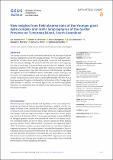Files in this item
New insights from field observations of the Younger giant dyke complex and mafic lamprophyres of the gardar province on Tuttutooq island, South Greenland
Item metadata
| dc.contributor.author | Koopmans, Lot | |
| dc.contributor.author | Webster, Robert A. | |
| dc.contributor.author | Changleng, Rory | |
| dc.contributor.author | Mathieson, Lucy | |
| dc.contributor.author | Murphy, Alasdair J. | |
| dc.contributor.author | Finch, Adrian A. | |
| dc.contributor.author | McCarthy, William | |
| dc.date.accessioned | 2021-07-14T09:30:10Z | |
| dc.date.available | 2021-07-14T09:30:10Z | |
| dc.date.issued | 2021-06-16 | |
| dc.identifier | 275052244 | |
| dc.identifier | 17614cf4-4da0-4aff-b26e-fabd1efe1104 | |
| dc.identifier | 85109020930 | |
| dc.identifier | 000680056200002 | |
| dc.identifier.citation | Koopmans , L , Webster , R A , Changleng , R , Mathieson , L , Murphy , A J , Finch , A A & McCarthy , W 2021 , ' New insights from field observations of the Younger giant dyke complex and mafic lamprophyres of the gardar province on Tuttutooq island, South Greenland ' , Geological Survey of Denmark and Greenland Bulletin , vol. 47 , 6526 . https://doi.org/10.34194/geusb.v47.6526 | en |
| dc.identifier.issn | 1604-8156 | |
| dc.identifier.other | ORCID: /0000-0002-3689-1517/work/97129622 | |
| dc.identifier.other | ORCID: /0000-0002-7214-1449/work/97129930 | |
| dc.identifier.uri | https://hdl.handle.net/10023/23544 | |
| dc.description | LK, RW, RC, LM and AM received funding from the Mining Institute of Scotland, Institute of Materials, Minerals and Mining, the Edinburgh Geological Society, the Augustine Courtauld Trust and the Scott Polar Research Institute. LK received funding from the Society of Economic Geology Hickok-Radford Fund. | en |
| dc.description.abstract | The Gardar Province of south Greenland is defined by the products of alkaline igneous magmatism during the Mesoproterozoic. The most laterally extensive Gardar intrusions are a series of giant dyke complexes best exposed on the Tuttutooq archipelago. We present new field observations and a geological map of north-east Tuttutooq island that provide fresh insights into the temporal evolution of the Younger giant dyke complex and two associated ultramafic lamprophyres. Our data demonstrate that distinctive crystallisation regimes occurred in different sectors of the dyke complex, leading to the formation of marginal gabbros and ovoid pod-like domains displaying lamination, modal layering and/or more evolved differentiates. We infer that at least two pulses of magma contributed to the formation of the Younger giant dyke complex. In addition, the relative ages of two ultramafic lamprophyre diatremes are constrained and attributed to two distinct phases of rifting in the Gardar Province. | |
| dc.format.extent | 7 | |
| dc.format.extent | 14494076 | |
| dc.language.iso | eng | |
| dc.relation.ispartof | Geological Survey of Denmark and Greenland Bulletin | en |
| dc.subject | Gardar Province | en |
| dc.subject | Lamprophyre | en |
| dc.subject | Magma chamber | en |
| dc.subject | Rift magmatism | en |
| dc.subject | Younger giant dyke complex | en |
| dc.subject | GE Environmental Sciences | en |
| dc.subject | QE Geology | en |
| dc.subject | Geology | en |
| dc.subject | NDAS | en |
| dc.subject.lcc | GE | en |
| dc.subject.lcc | QE | en |
| dc.title | New insights from field observations of the Younger giant dyke complex and mafic lamprophyres of the gardar province on Tuttutooq island, South Greenland | en |
| dc.type | Journal article | en |
| dc.contributor.institution | University of St Andrews. School of Earth & Environmental Sciences | en |
| dc.contributor.institution | University of St Andrews. Scottish Oceans Institute | en |
| dc.contributor.institution | University of St Andrews. St Andrews Isotope Geochemistry | en |
| dc.identifier.doi | https://doi.org/10.34194/geusb.v47.6526 | |
| dc.description.status | Peer reviewed | en |
| dc.identifier.url | https://geusbulletin.org/index.php/geusb/article/view/6526/14176 | en |
This item appears in the following Collection(s)
Items in the St Andrews Research Repository are protected by copyright, with all rights reserved, unless otherwise indicated.

